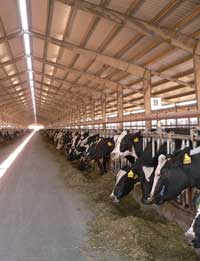Large-scale dairying in USA shows welfare second to none

Nocton Dairies’ plans for an 8100-cow dairy unit in Lincolnshire have raised fears over “factory farming” and poor animal welfare.
But following a recent trip to Idaho looking at large scale dairy units of up to 13,500 cows Aly Balsom says those fears might be overstated
No matter what the scale of the operation, no farm can be profitable without high standards of animal welfare – having a herd of more than 10,000 cows emphasises this point.
Any issue would have huge consequences on such a scale and, as a result, they simply cannot afford for there to be a problem.
The trip included a wide range of farmers from across the UK, farming several hundred to 1000 cows, but across the board, all came away believing the level of animal welfare on these large units was “second to none”.
Everyone struggled to spot a lame cow, with many herds achieving more than 11,000 litres a cow a year with somatic cell counts of less than 100,000 cells/ml – you simply can’t achieve these kind of figures without high welfare.
The fact is, you can’t manage these herds without regimental procedures – the economies of scale dictate that management is top-notch.
These larger unit can afford to assign set people to set tasks – a group of staff will have the job of calving cows, another, managing fresh calvers. In this way, each staff member’s attention is focused on one area.
Although smaller units here in the UK may not be able to warrant this luxury, considering staff numbers, there’s no doubt a lot can be learned from these large units, whatever the size of your herd.
Putting in protocols at calving, so that everyone knows exactly how much colostrum to give calves, or clearly summarising how to treat cases of metritis, will go a long way to getting cows off to a good start and ensuring all get proper attention.
Undoubtedly these large-scale units contradict any claims large cow numbers mean low cow welfare and, if Nocton adheres to the principles outlined by our USA counterparts, there’s no reason why they cannot produce a facility with first-rate animal welfare.
For pictures and videos from Idaho, visit www.fwi.co.uk/idaho
